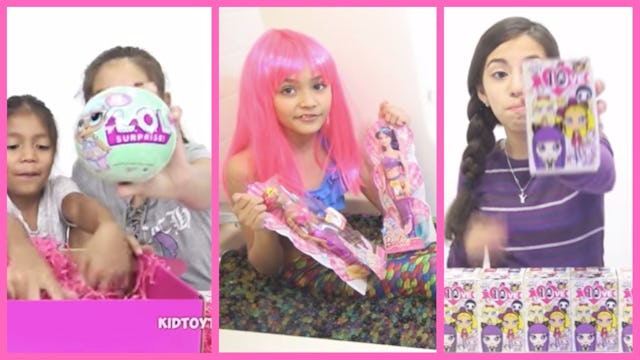Toymakers Are Targeting Your Kids Via Those Annoying YouTube Channels

“Kid influencers” are the ones marketing toys now
If there ever was an article that needed to start with the phrase, “Kids these days…” it’s this one. Because we of the folks-who-just-learned-we’re-so-old-we-don’t-understand-kids-these-days generation have just learned that toymakers no longer focus their marketing on the TV commercials that appear during episodes of your kids’ favorite shows. That’s because kids don’t have favorite TV shows anymore, they have favorite YouTubers. And those YouTubers are the ones who advertise the toys our kids beg for when we’re trying to get the hell out of Target without spending more than $50.
Nothing will make you feel as old and confused as an article on Bloomberg Businessweek titled, “Toymakers Are Targeting Your Children Via YouTube’s Kid Influencers.” That’s because not only did we not know that TV commercials for toys are becoming passé, but also what in holy hell is a “kid influencer” and why does that term make us want to take a preemptive nap and a dose of Ibuprofen?
Let’s start with the first issue: the fact that the Saturday mornings and after-school hours that kids used to spend watching TV are now times when they log on to YouTube and watch videos instead. It’s not cartoon characters that they love anymore, it’s YouTubers.
I remember the first time I heard the word “YouTuber.” It went something like this:
“Mom, Jack and Diane are my favorite YouTubers.”
“Nuhoobers?”
“YouTubers.”
“Fahznootzle?”
“YouTubers! And I want to be one when I grow up!”
“Ha! That’s funny the way you make up words.”
According to the Bloomberg article, toy companies are producing best-sellers that aren’t marketed on TV at all anymore. In fact, companies like MGA Entertainment, Inc. (makers of Bratz and Lalaloopsy dolls) now allocate 90% of their marketing to the digital realm.
Image via YouTube/ Kid Toy Testers
The fact is, kids are watching less TV than ever before. Viewership of channels like Sprout, The Disney Channel, and Nickelodeon have been steadily decreasing — in the case of Nickelodeon, their number of daily viewers dropped by more than half between 2012 and 2015. Meanwhile, 5.6 billion viewers watched kid-centered YouTube videos in the first quarter of 2015, an increase of 224% in just one year.
And here we thought that saying our kids barely watched TV would mean they were spending time outside or something. What a bunch of dummies we are, huh?
So what the heck are kids watching on YouTube? Let’s go back to our second confused old-person question, which is “what is a ‘kid influencer’?” A “kid influencer” is someone like 5-year-old Ryan of the YouTube channel Ryan Toys Review, whose parents record him playing with toys for their 9.3 million subscribers. At one point, Ryan’s channel was the most popular channel on the site and netted the family approximately $1 million a month in advertising revenue.
Image via YouTube/ Ryan’s Toy Review
That’s $12 million dollars a year for posting videos of your kid playing with toys.
That is insane. And also kind of gross. But most of all it’s grossly insane. Here’s how Lee, the dad behind Kid Toy Testers describes the workload for his five homeschooled children, who are between the ages of 2 and 14: “We have 15-to-20-hour workdays, and it’s seven days a week every day of the year…Sometimes it’s three to four in the morning when we finish editing. A lot of times we don’t see sunshine because we’ve been shooting in the basement for a couple days in a row and wonder what day of the week it is.”
That’s healthy.
These so-called “unboxing” videos are all the rage on YouTube because, apparently, kids love watching other kids open up and play with toys. This makes about as much sense to us as those videos our kids watch of other people playing video games. Why are these things? We don’t know. But they are earning a lot of people a lot of money and are quickly becoming the centerpiece of many kids’ online viewing. “Kid influencers” have become so important to toy companies that many of them follow these kids online. They send them free toys in the hope that they will put them on their channel. And then our kids watch them and pay for their college.
It’s a grossly insane, bizarro world we live in, folks.
This article was originally published on